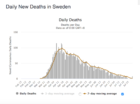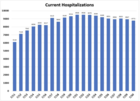“
If Sweden stops at about 5,000 or 6,000 deaths, we will know that they’ve reached herd immunity, and we didn’t need to do any kind of lockdown.”
Dr. Michael Levitt, Nobel Laureate (chemistry and structural biology at Stanford University), May 04, 2020
https://www.stanforddaily.com/2020/...-19-curve-could-be-naturally-self-flattening/
As of 31 July, Sweden has 5,743 deaths, with a daily growth rate ~0.2% for the past 22 days and dropping to near 0.1% over the last 7 days.
-
And Sweden reported more COVID-19 deaths for the single day of 31 July than its neighbor Norway reported for the entire month of July combined, though both were in the very enviable single-digit range.
By mid-July fewer than 20% of Swedes showed serological evidence of past SARS-CoV-2 infection. Sweden is nowhere near herd immunity for a virus with an R0 of 2.5 or more.
If 5-6 thousand COVID-19 deaths in a population of ~10 million (Sweden) translated into herd immunity, as Levitt predicted, the U.S. would already be there (~160K deaths in a population of ~330M) with the same pattern of decline and current low daily death count that Sweden began in mid-April (and the same trajectory that the U.S. was on between mid-April and mid-June). But that's not what has happened.
The U.S. reversed course around Memorial Day, with the 2-week lag in reported cases and a 6-week lag in the daily deaths that resulted. Our current 7-day moving average of daily deaths reported has been >1000 for the past several days, growing exponentially at 0.7%/day. This is likely to continue for another few weeks, lagging the growth in Sun Belt cases by about a month.


Three months ago Levitt predicted that the global daily death count for COVID-19 would peak between mid-July and 10 August. He isn't demonstrably wrong yet, but will be shortly. For Levitt's prediction to hold (
i.e., for "
the peak" to exceed April's highs) the 7-day moving average of reported daily global deaths would have to increase by 25% in the next 9 days, and I don't think that will happen, since it has grown less than 4% in the past 9 days, and the rate of growth is declining rather than increasing (see below).
Levitt's models use a Gompertz function to predict the number of cases and deaths. A Gompertz function increases monotonically but at an exponentially decreasing rate. In other words, it can't account for an increase in slope, like the one we actually observe after the first peak in mid-April in the U.S., or the one we are seeing globally now (below). The Gompertz function works fine for Sweden, Italy, and other countries that have not seen a resurgence (so far).

If you read
Levitt's (et al.) preprint from a month ago (Table 3), ironically deposited just at the time the recent U.S. surge started, his/their model predicted a
plateau in U.S. COVID-19 cases at 2.1 million, even though the actual number of cases was already known to be 2.3 million. We're at more than twice that "plateau" today, with cases growing exponentially at 1.5%/day (doubling time 1.5 months).
My hat's off to Levitt
et al. for sticking their necks out, but they missed this one by a country mile. Not alone in that camp, of course, even among people who are actual epidemiologists.






















